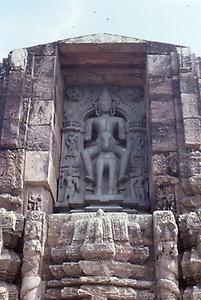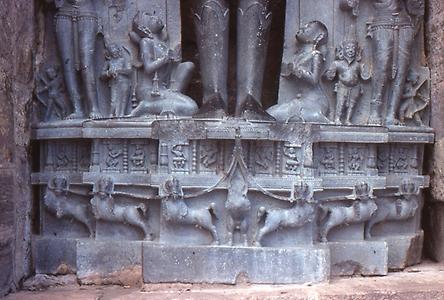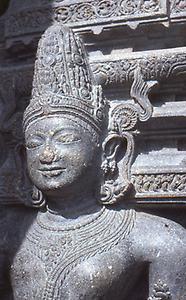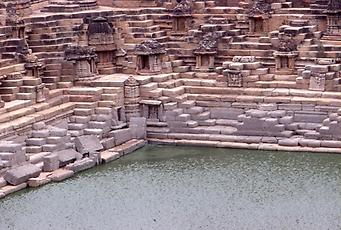Where the carriage made of stone thundered accross the roads.#
The sun-temple of Indian Konarak#
By
All photos were taken by the author from 1978 to 2004 and are from his archive "Pictureflood".
At the coast of the northeastern province of India, Orissa, there is a huge ruin of a Hindu temple dedicated to the sun god Surya. Aeons ago it was already a landmark for shipping. In contrast to the white washed walls of the Jagannatha-temple in Puri, time has turned the temple dark, and hence it is called the "black pagoda".
Today it is located a bit inland. The 70 m hight tower that was protecting the most holy part of the temple has collapsed a long time ago. But the foundations on which the carriage of the sun rests are still intact. This also includes kilometer long reliefs, the niches with figures of the god, and the entrance to what was once the hall of dance. Also, the main aspect that makes the temple unique and hence is now part of UNESCO world heritage is the fact that the whole construction has been built as a carriage on wheels of stone, and like the carriage of the myths, it is drawn by horses of stone.
There is hardly any spot in this architecture, that is not enriched by pictoral and ornamental adornments. All realms, from gods to humans, from myths to the spheres of cosmos are included. The miniature sculptures are so dominating in sheer numbers that they- in a sense- are more impressibe then the large pictures of the god, the horses of stone or the elephants of stone that stand on guard. There is no end to studying all details.
The temple was built in the 13 th century A.D. by a king who was then ruling the dynasty in Orissa, and was built at the place of an earlier building of which little is known. The building probably was to celebrate some military victory. Invading Muslims hoards have certainly destroyed much of the statues and pictorial representations. However, what remains is still indicating the architectural miracle of the temples. That the temple is now in ruins is certainly also due to the forces of nature, including sand from the beach that would destroy small deails like the work of sand paper. Also, the cult of the god of sun ceased to be as intense as it remained for the main gods like Shiva, Kali and Vishnu.
The name Surya is the term for sun in the old Indian language. From a linguistic point of view it corresponds to the Greek "helios", the Latin "sol", the old German ("Althochdeutsch") "sunna". Sanskrit belongs to the indo-arian group of the indo-germanic languages. In India, Surya is the personification of sun, light and warmth.
In the oldest written lengends of India, the Veden, it never quite reached the level of main gods like Vishnu and Shiva, a fact explaining that not many temples are dedicated to Surya.
Surya belongs to the Dadityas, the twelfe gods of the Veden, whose highest one is Indra, the god of thunder. Surya is also seen as manifestation of the god of fire, Agni. His parents are the god of heaven Dyaus (corresponding to Zeus or Jupiter in ancient European religions) and the personification of the earth, Prithivi. His sister Usha is the goddess of sunrise (comparable to the Greek Eos). All this is just one more indication how closely indogermanic languages and myths are interwoven.
The statues of Surya in open niches show the damage done by Muslimic barbarians. But they also still show the incredible work invested by the sculptors in showing details of figures and clothing.
In pictures, Surya is shown three times, to symbolize morning, mid-day and evening.
His carriage (Sanskrit: vimana) was constructed by the heavenly craftsman from rays of the sun. It is pulled by seven horses corresponding to the seven days of the week. The coachman is Aruna, god of the rising sun. One of the wives of Surya is also with him: Her name is Chaya, meaning shadow. She is the opposite of the glaring sun Surya.
The carriage of stone is pulled by seven horses in full harness.
Powerfull and furious horses and elephants are accompanying the carriage to destroy all possible attackers.
The construct is also hiding much numerical mysticism connected to time. The sun defines time by its passage across the sky. The carriage has 24 wheels for the lunar phases according to Indian tradition. And the wheels as such are miracles. They have 8 spokes, symbolizing the 8 periods of a day as was traditional in old India.
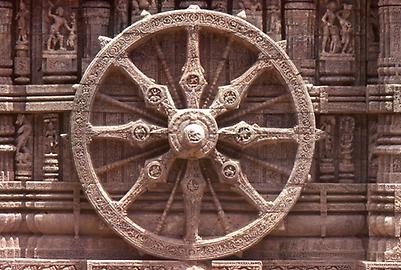

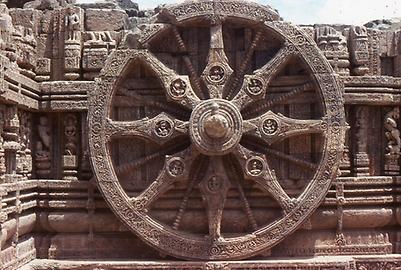








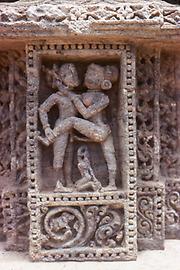

In addition the temples of Khajuraho, Konarak is also known for pictures of sexual scenes, for European minds close to or beyond the border of pornography. The all powerful procreational powers of nature emanating form the light and the warmth of the sun are the background for thoses pictures that for Indians are not overly erotic but are just part of Ars amatoria (the art to make love), similar to what the old Indian Kamasutram was supposed to do: to teach techniques for making love.
Also, the notion of a cosmos emitting sounds are similar to the ideas of old Greece and Rome. In "Somnium Scipionis" (the dream of Scipio) by Cicero the idea that our world is at the center of spheres presenting the orbits of the planets is described, each sphere responsible for a certain sound, thus filling the universe with unearthly music.
In the prologue in heaven of Goethe's "Faust" this is formulated essentially as follows:
The sun rings strong as he competes
with songs of all the other spheres
and ends its predetermined path
dramatically, much like thunder.
His view pours strength into the angels.
A secret that remains for all;
Accomplishments too large to fathom
are glorious since the beginning.
In the sun-temple of Konarak you can believe to hear how the wheels of Surya's carriage thunder over the roads of stone. This picture keeps reoccuring in all cultures and epoches as reflected in Goethe's "Faust", Part II in the song of Ariel:
Hear! Hear the storm of years!
Makes music for those special ears
announcing days with newborn tears.
The doors of rock are closing hard
As Phoebos wheels propell his cart.
A sea of noise is brought by light.
Even the lower part of the carriage is decorated elaborately and is carried by small elephants.

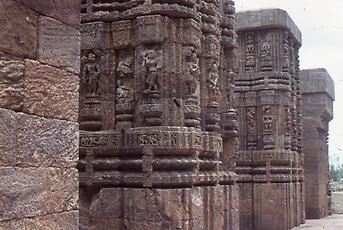
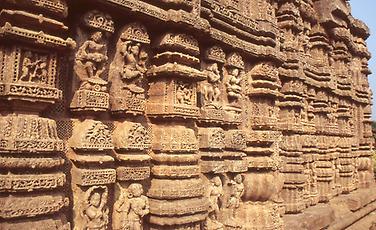


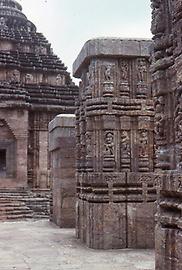

It seems that all eventualities have been covered. Waterspouts with grotesque heads make sure that the carriage stays dry even during the wild rains of the monsoon season.
It is interesting to compare the Konarak sun-temple with the one in Modhera in the province of Gujarat. The latter has been very much destroyed by Mulims hoards. Since it is built near a cultic lake the temple provides an atmosphere quite different from the one protected by UNESCO heritage.
The maimed body of Surya of Modhera on his carriage. The Muslim objection to pictorial presentations has turned here into horrible barbarism. What one still can see are the two Lotus flowers in the hands of the god as his very symbols.








